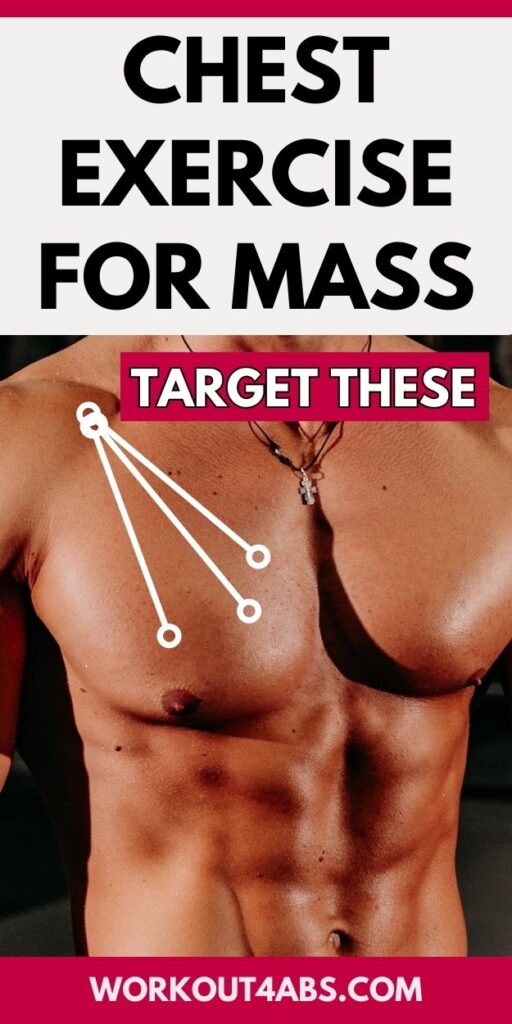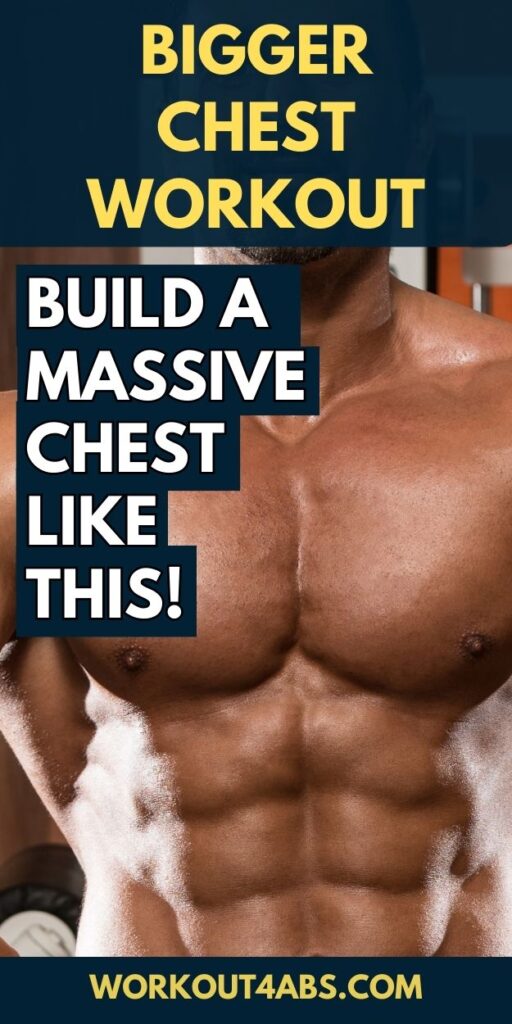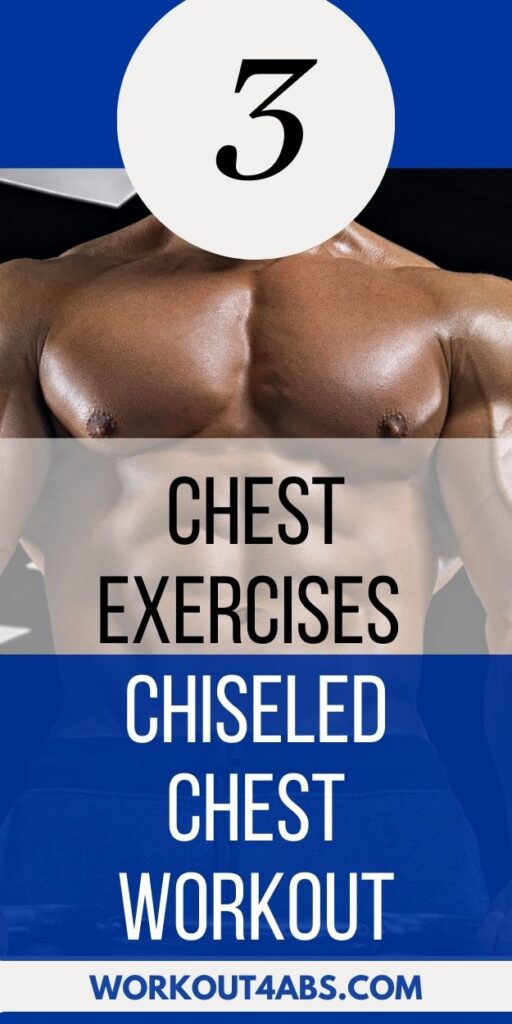Are you ready to learn how to gain chest muscle? In the pursuit of building impressive chest muscles, a strategic training approach is paramount. The bench press, an undisputed heavyweight in the realm of chest-focused exercises, deserves the spotlight as the centerpiece of your routine. Its capacity to foster sheer strength should not be underestimated – a fundamental element in muscle growth. Anchoring your regimen around this powerhouse movement provides the foundation. As you aim to maximize your chest development, remember that training volume is key, granting your muscles the stimulation they crave for growth. Conclude your session with the chest fly exercise, unfurling a profound stretch that complements the intensity of the bench press.
If you enjoyed these tips, please save this pin to your Pinterest Board.

Increase Chest Size by Performing the Correct Exercise with Correct Technique
Performing exercises with correct form is crucial for effectively increasing the size of your chest muscles for several reasons:
- Targeted Muscle Activation: Proper form ensures that you’re effectively targeting the muscles you intend to work on. When you use the correct technique, you engage the chest muscles more directly, leading to better muscle activation and growth.
- Safety and Injury Prevention: Incorrect form can put unnecessary stress on joints, tendons, and ligaments, increasing the risk of injury. Using the correct form ensures that your body moves in a biomechanically efficient and safe manner, reducing the chance of strains, tears, or other injuries.
- Muscle Fiber Recruitment: Using proper form allows you to recruit a higher number of muscle fibers within your chest muscles. This is important because the more muscle fibers you engage during an exercise, the more potential for growth and strength development.
- Balanced Development: Correct form helps prevent imbalances between different muscle groups. A balanced workout routine that targets all aspects of the chest muscles, including upper, lower, and inner areas, contributes to a more aesthetically pleasing and functionally strong chest.
- Progressive Overload: Proper form allows for gradual and progressive overload. As you become stronger, you can increase the weights you lift, the repetitions you perform, or the intensity of the exercise. This gradual progression is a key factor in muscle growth over time.
- Mind-Muscle Connection: Using the right form encourages a strong mind-muscle connection. This means you’re more aware of the muscle you’re working, which can lead to better muscle engagement and more effective contractions during exercises.
- Effective Range of Motion: Correct form ensures that you’re using a full range of motion for an exercise. This is vital for stimulating muscle growth throughout the entire muscle length. Partial or improper range of motion can limit the effectiveness of an exercise.
- Plateau Avoidance: Over time, your muscles can adapt to a specific exercise if it’s performed with incorrect form. This can lead to plateaus in muscle growth. Employing proper form helps you avoid such plateaus by consistently challenging your muscles in the right way.
- Long-Term Sustainability: Using proper form minimizes wear and tear on your joints, which contributes to long-term sustainability in your fitness journey. By avoiding injuries and strain caused by poor form, you can maintain consistent progress over the years.
- Quality vs. Quantity: It’s not just about how much weight you lift or how many reps you do; it’s about the quality of your movement. Focusing on proper form emphasizes quality over quantity and ensures that each repetition is contributing to your muscle growth.
In summary, performing the correct exercises with the right form is essential for maximizing the growth of your chest muscles. It promotes targeted muscle activation, safety, balanced development, effective muscle fiber recruitment, and other factors that collectively lead to better results and a reduced risk of injuries. If you’re unsure about your form, consider working with a qualified fitness professional to guide you through your exercises and ensure you’re getting the most out of your workouts.
Primary Pushing Movement (Flat Bench Press)
The way a muscle attaches to the skeleton plays a crucial role in determining how it responds to different movements. Muscles are attached to bones via tendons, and the specific arrangement of these attachments influences the range of motion, strength, and effectiveness of various exercises. Let’s explore this concept further using the example of the barbell bench press and its impact on the pectoral muscles (pecs).
- Anatomical Considerations: Muscles have two main types of attachments: origins and insertions. The origin is typically the more stable attachment point, often closer to the body’s center, while the insertion is usually the more mobile attachment point, farther from the body’s center. The direction in which a muscle crosses a joint determines its action when it contracts.
- Barbell Bench Press and Pectoral Muscles: The barbell bench press is a compound exercise that primarily targets the pectoralis major muscles (pecs) along with other secondary muscles. The movement of the bench press involves horizontal adduction, which is the movement of bringing the upper arm across the front of the body, towards the midline. In the bench press, this movement is performed when you push the barbell away from your chest.
- Pectoral Muscle Attachment: The pectoralis major muscle has multiple heads (clavicular and sternal heads) and is attached to the humerus (upper arm bone) at the front of the shoulder. The clavicular head attaches to the clavicle (collarbone), and the sternal head attaches to the sternum (breastbone) and the upper ribs. When the pectoral muscles contract, they pull the upper arm towards the midline, leading to horizontal adduction of the shoulder joint.
- Effect on Movement: Due to the attachment of the pectoral muscles on the humerus and their orientation, they are optimally positioned to perform horizontal adduction. When you perform a barbell bench press, the movement pattern aligns with the anatomical arrangement of the pectoral muscles, effectively engaging them in the motion.
- Other Factors: While the pectoral muscles are the primary movers in the barbell bench press, other muscles are also involved, such as the anterior deltoids (front shoulder muscles), triceps, and even the stabilizing muscles of the core. These muscles work together to perform the press while also ensuring stability and control.
In summary, the way a muscle attaches to the skeleton greatly influences its response to different movements. The example of the barbell bench press and the pectoral muscles demonstrates how the attachment points of the muscles determine the direction in which they can exert force effectively. Understanding these anatomical principles is essential for designing effective workout routines that target specific muscle groups and movements while minimizing the risk of injury.
If you enjoyed these tips, please save this pin to your Pinterest Board.

Clavicular Head (Incline Bench Press)
The incline bench press is known to activate the upper chest muscles (clavicular portion of the pectoralis major) more effectively compared to the flat bench press. This difference in activation is due to the biomechanics and anatomical considerations involved in the exercise. Additionally, having exercises that incorporate shoulder flexion while pushing is important for achieving a well-rounded chest workout. The dumbbell incline bench press further enhances upper chest engagement by allowing the humerus to move across the body in horizontal adduction.
- Biomechanics of Incline Bench Press: In the incline bench press, the bench is set at an angle (usually around 45 degrees) which positions the torso at an incline. This changes the alignment of the shoulder joint and the movement pattern of the arms compared to the flat bench press. The incline angle facilitates greater shoulder flexion during the pushing phase of the lift.
- Upper Chest Activation: The upper chest muscle fibers are better aligned to work during movements involving shoulder flexion. When you perform the incline bench press, the angle of the bench and the increased shoulder flexion place more emphasis on the clavicular portion of the pectoralis major. This leads to a more targeted activation of the upper chest muscles compared to the flat bench press.
- Shoulder Flexion and Balanced Development: Including exercises that involve shoulder flexion in your chest workout helps achieve balanced chest muscle development. While the flat bench press is excellent for overall chest strength, the incline bench press ensures that the upper chest is also effectively targeted, contributing to a well-rounded chest appearance.
- Dumbbell Incline Bench Press and Horizontal Adduction: The dumbbell incline bench press takes the upper chest engagement a step further. When you use dumbbells, your arms are free to move independently of each other. As you lower the dumbbells towards your chest, the angle of the incline allows your upper arms (humeri) to move across your body in a horizontal adduction motion. This movement pattern mimics the natural range of motion of the upper chest fibers and enhances their activation.
- Muscle Activation and Efficient Contractions: The ability to perform horizontal adduction during the dumbbell incline bench press optimally engages the upper chest muscles, leading to more efficient muscle contractions. The exercise allows you to work through a wider range of motion, which can lead to better muscle fiber recruitment and growth.
In summary, the incline bench press activates the upper chest muscles more effectively compared to the flat bench press due to the biomechanics of the exercise and the alignment of muscle fibers. The inclusion of exercises that incorporate shoulder flexion during pushing movements is crucial for achieving balanced chest development. The dumbbell incline bench press takes this a step further by allowing the humerus to move across the body in horizontal adduction, resulting in targeted engagement of the upper chest muscles. This combination of anatomical alignment and movement patterns helps maximize the effectiveness of your chest workout and contribute to a well-developed chest.
If you enjoyed these tips, please save this pin to your Pinterest Board.

Close Grip Bench Press
The close grip bench press is an effective exercise for targeting the chest muscles, particularly the clavicular head of the pectoralis major, due to the way it alters the muscle activation pattern based on hand spacing. The clavicular head is one of the two main divisions of the pectoralis major muscle, and it is situated in the upper part of the chest, closer to the collarbone. Here’s how the close grip bench press achieves this targeted activation:
- Muscle Anatomy and Hand Placement: The pectoralis major muscle has two primary heads: the sternal head (lower chest) and the clavicular head (upper chest). The fibers of the clavicular head are oriented diagonally, allowing them to better engage during movements involving shoulder flexion, such as pressing motions.
- Close Grip Hand Placement: The close grip bench press involves bringing the hands closer together on the barbell compared to the traditional, wider grip used in the standard bench press. This narrower hand placement changes the angle of the humerus (upper arm bone) relative to the torso and the direction of the muscle fibers.
- Increased Shoulder Flexion: The close grip bench press encourages greater shoulder flexion due to the narrower hand placement. When you bring your hands closer together, the angle of the upper arms changes, causing more emphasis on the clavicular head of the pectoralis major.
- Clavicular Head Activation: As you perform the close grip bench press, the increased shoulder flexion and the diagonal orientation of the clavicular head’s muscle fibers align more effectively. This leads to enhanced activation of the clavicular head, resulting in a more targeted and intense workout for the upper chest.
- Balanced Chest Development: Incorporating exercises like the close grip bench press alongside other chest exercises can help achieve a more balanced chest development. While the traditional bench press engages the entire chest, including the sternal head, the close grip version gives specific attention to the upper chest region.
- Mind-Muscle Connection: Engaging the clavicular head through the close grip bench press requires a strong mind-muscle connection. Focusing on consciously contracting the upper chest muscles during the exercise can further enhance the activation of the clavicular head.
In summary, the close grip bench press is an effective exercise for targeting the clavicular head of the pectoralis major muscle due to its hand placement, which promotes greater shoulder flexion and optimal alignment of muscle fibers. This exercise provides a unique way to emphasize the upper chest, contributing to a well-rounded and balanced chest development. However, it’s important to note that while the close grip bench press is excellent for targeting the upper chest, it’s still important to include a variety of exercises in your routine to ensure comprehensive chest muscle development.
Deep Stretch Short Contraction
The chest fly exercise is often considered a great exercise to end a chest workout due to its unique benefits for targeting the chest muscles as a whole, providing a deep stretch, and facilitating a strong mind-muscle connection. Ending with chest flys can help maximize muscle engagement and promote overall chest development. Here’s why it’s effective:
- Comprehensive Chest Engagement: The chest fly exercise involves horizontal adduction, where you bring your arms together across the midline of your body. This motion engages the entire pectoralis major muscle, working both the upper and lower portions of the chest. As you’re nearing the end of your workout, the chest fly ensures that you’ve thoroughly worked all parts of your chest.
- Deep Stretch and Muscle Activation: The chest fly is known for providing a deep stretch in the chest muscles at the bottom of the movement. This stretch is essential for muscle growth and flexibility. The eccentric (lengthening) phase of the exercise during the stretch activates muscle fibers differently than other chest exercises, contributing to overall muscle development.
- Mind-Muscle Connection: Chest flys require a strong mind-muscle connection to execute properly. Feeling the stretch, contraction, and movement of the chest muscles during each repetition helps you establish a better connection with the muscles you’re working. This heightened awareness enhances muscle engagement and can lead to more effective contractions.
- Full Range of Motion and Elbow Extension: Ending the movement of the chest fly by straightening the elbows is crucial for maximizing muscle engagement. When you straighten your elbows at the end of the movement, it allows the humerus (upper arm bone) to go further across the body. This motion promotes a full short contraction of the chest muscles, emphasizing the point of maximal contraction.
- Completing the Short Contraction: The point where you straighten your elbows at the end of the movement helps engage the muscle fibers to their fullest extent, contributing to a strong muscle contraction. This emphasis on the contraction phase of the exercise helps stimulate muscle growth and adds to the overall effectiveness of the chest fly.
By incorporating chest fly’s at the end of your chest workout, you take advantage of the exercise’s ability to work the chest muscles as a whole, provide a deep stretch, and create a strong mind-muscle connection. The focus on completing the movement by straightening the elbows adds an additional layer of targeted engagement, ensuring that you’ve effectively worked the chest muscles from a variety of angles and movement patterns.
Home › Posture Exercises ›How to Gain Chest Muscle